Ever wonder why some agency owners seem to effortlessly attract clients through LinkedIn while others struggle to get noticed?
The difference often comes down to personal branding. For agency owners and founders, a strong LinkedIn personal brand isn't a luxury-it's a business necessity that opens doors to new clients, partnerships, and opportunities.
According to LinkedIn's own research, content reaches 20x more people through personal profiles than company pages, with 4 out of 5 LinkedIn members driving business decisions in their organizations. This makes the platform uniquely powerful for reaching decision-makers who are actively seeking business solutions.
This guide will walk you through a practical, step-by-step approach to building a LinkedIn personal brand that generates tangible results for your agency.
Step 1: Define Your Brand Foundation
Before jumping into profile updates and content creation, you need to establish a clear foundation for your personal brand. This foundational work might seem tedious, but skipping it leads to inconsistent messaging that confuses potential clients.
Identify Your Brand Pillars
Think of brand pillars as the core themes that will define your LinkedIn presence. These should sit at the intersection of three key areas: your genuine expertise, your audience's pressing needs, and your business objectives.
For a digital marketing agency owner, effective brand pillars might include conversion rate optimization, marketing analytics, customer journey mapping, and marketing automation. Each pillar represents an area where you have deep knowledge and that directly connects to services your agency provides.
The key is specificity. Rather than positioning yourself broadly as a "marketing expert," drilling down into specific disciplines creates clearer differentiation. As marketing expert Mark Ritson notes in his Marketing Week column: "The riches are in the niches. Specialization is increasingly the only viable position in a crowded marketplace."
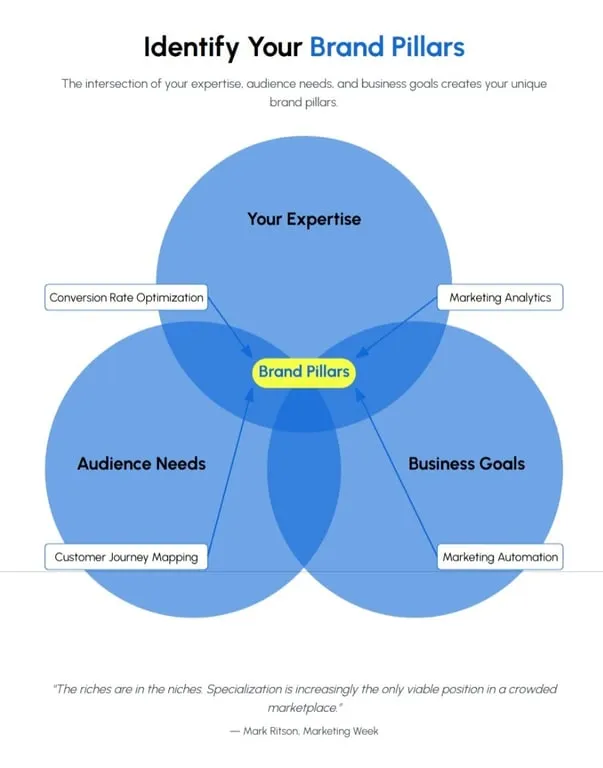
Craft Your Brand Positioning Statement
Your positioning statement articulates what makes your approach distinctive. This internal document serves as your North Star for all content decisions, ensuring consistency across your LinkedIn presence.
An effective positioning statement answers four key questions:
-
Who specifically do you help? (Target audience)
-
What primary problem do you solve? (Pain point)
-
How do you solve it differently? (Methodology)
-
What unique perspective or experience informs your approach? (Differentiator)
For example, a web development agency might use: "I help SaaS startups transform complex user experiences into intuitive interfaces through human-centered design methodologies, drawing on 15 years of cognitive psychology research."
This positioning probably won't appear verbatim in your profile, but it will inform everything from your headline to the content you create.
Step 2: Optimize Your LinkedIn Profile
Your LinkedIn profile isn't just a digital resume-it's a strategic marketing asset. Each section should be crafted to communicate your brand positioning while appealing to your ideal clients.
Create a Compelling Headline
Your headline appears everywhere you engage on LinkedIn-in search results, comment sections, connection requests, and the "People Also Viewed" sidebar. It's prime real estate that deserves careful consideration.
The most effective headlines follow a clear structure:
[Who you help] + [How you help them] + [Proof point or credential]
For instance, "Helping B2B SaaS Companies Double Conversion Rates | CRO Strategy for High-Growth Tech | Featured in Forbes & TechCrunch"
This formula works because it immediately signals relevance to your ideal clients while establishing credibility. According to research by LinkedIn Sales Solutions, headlines that focus on client outcomes receive 72% more profile views than title-focused headlines.
For more headline examples and formulas, our guide on LinkedIn headlines that stand out provides tested templates for various industries.
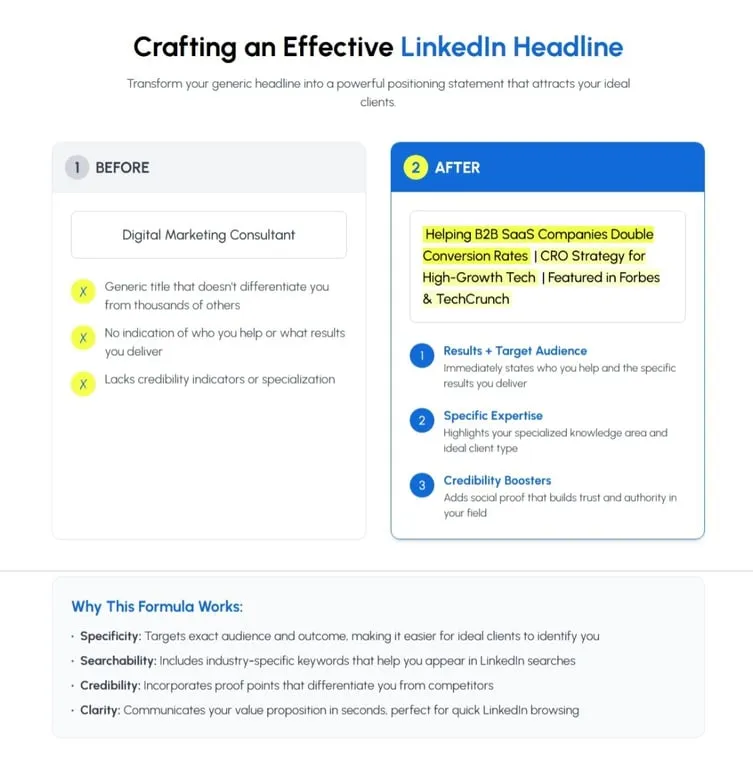
Craft an Engaging About Section
Your About section (formerly called Summary) is where casual profile visitors become genuinely interested in your expertise. The key challenge is balancing personality with professionalism while clearly communicating your value proposition.
The most successful About sections follow a narrative structure:
First paragraph: Open with an intriguing statement or question that addresses your audience's key challenge. This hooks visitors and makes them want to read more.
Second paragraph: Explain your personal connection to this problem-what led you to focus on this area? This builds authenticity and emotional connection.
Third paragraph: Outline your approach to solving the problem, highlighting what makes your methodology different.
Fourth paragraph: Provide proof of your expertise through results, credentials, or experience.
Final paragraph: Include a clear call-to-action that guides visitors on what to do next (connect, message you, etc.)
A study by LinkedIn's Economic Graph team found that profiles with complete About sections receive up to 3.9x more opportunities through LinkedIn than those with minimal information.
For detailed examples and templates, our LinkedIn About section guide provides industry-specific frameworks that maintain authenticity while driving results.
Showcase Your Best Work in Featured
LinkedIn's Featured section appears prominently near the top of your profile, making it ideal for highlighting your best work. This section turns abstract claims into concrete evidence by showcasing actual projects, content, and results.
The most effective Featured sections include:
A signature article or post that encapsulates your core expertise. This should be substantial content that demonstrates deep knowledge of one of your brand pillars.
A client case study or success story that illustrates your methodology in action. Concrete results with specific metrics are particularly effective here.
Media appearances, interviews, or speaking engagements that establish third-party validation of your expertise.
Research from Content Marketing Institute indicates that profiles with robust Featured sections convert visitors to connections at nearly twice the rate of those without.
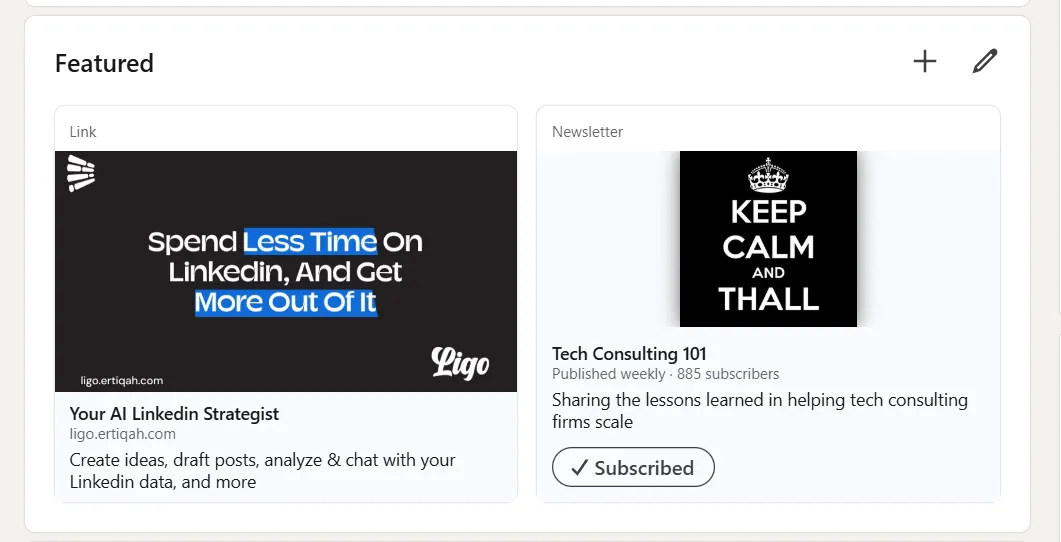
Complete All Profile Sections Strategically
While your headline, About, and Featured sections drive first impressions, a fully optimized profile strengthens your credibility and improves discoverability through LinkedIn's search algorithm.
Your Experience section should focus on achievements and outcomes rather than responsibilities. For agency owners, highlight specific client results and business growth metrics for each role.
The Skills section affects LinkedIn's algorithm and should align with your brand pillars. Prioritize skills that your target clients might search for, and aim to receive endorsements from credible connections in your network.
Recommendations provide powerful social proof. Aim for 5-10 quality recommendations from clients and respected colleagues that specifically mention outcomes you've helped them achieve.
For a comprehensive approach, our LinkedIn profile checklist provides a systematic framework for optimizing every section.
Step 3: Develop Your Content Strategy
Content is the engine that builds your personal brand on LinkedIn. A strategic approach to content creation ensures maximum impact with minimum wasted effort.
Choose Content Themes Based on Your Brand Pillars
Your brand pillars provide the foundation for your content themes-the specific topics you'll address regularly. For each pillar, develop 3-5 content themes that allow you to explore different aspects of your expertise.
For example, if "conversion rate optimization" is one of your brand pillars, potential content themes might include:
Educational: User psychology principles that drive conversion Process-focused: How to conduct effective A/B tests Result-oriented: Case studies of successful optimization projects Trend analysis: Emerging CRO techniques for 2025 Myth-busting: Common misconceptions about conversion optimization
This thematic approach creates cohesion in your content while providing enough variety to maintain audience interest. Research by Content Marketing Institute shows that 88% of top-performing content marketers use a documented content strategy organized around core themes.
Using LiGo's content themes feature, you can define these themes once and generate ideas that consistently reinforce your expertise areas, saving significant time in content planning.
Balance Content Formats for Maximum Impact
Different content formats serve different purposes in your personal branding strategy. Understanding when to use each format improves engagement and expands your reach.
Text posts drive the highest engagement-to-effort ratio and should form the foundation of your content strategy. The ideal length for text posts is 1200-1500 characters (just under LinkedIn's "see more" threshold), with short paragraphs for readability.
Document carousels are excellent for step-by-step processes, data visualization, or comprehensive guides. Research by LinkedIn Marketing Solutions indicates carousels receive 3x more engagement than standard text posts but require more production effort.
Native video builds stronger personal connection through facial expressions, voice, and body language. According to Social Insider's research, native video generates 5x more engagement than external links but demands higher production quality to maintain professionalism.
LinkedIn articles establish deeper expertise on complex topics and perform better for SEO. While they typically receive less engagement than feed posts, they create lasting value and can be referenced in your other content.
According to our analysis of LinkedIn post formats, the most effective approach combines frequent text posts (3-4 weekly) with periodic high-value assets in other formats (1-2 monthly).
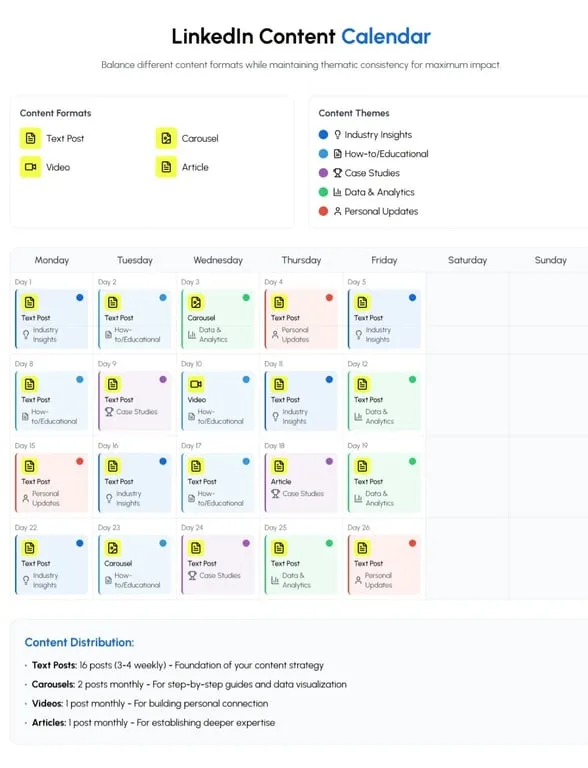
Develop a Sustainable Publishing Cadence
Consistency matters more than frequency when building a personal brand on LinkedIn. An erratic posting schedule signals unreliability to both the algorithm and your audience.
The optimal posting frequency depends on your capacity and audience engagement patterns. Starting with 3 posts per week provides sufficient visibility without overwhelming your creation capacity. This frequency can be adjusted based on performance data and your available time.
According to research from Hootsuite, Tuesday, Wednesday, and Thursday between 8am-2pm tend to be high-engagement windows for LinkedIn, but your optimal times may vary based on your specific audience.
LiGo's analytics can identify your audience's peak engagement times and automatically schedule content for maximum visibility, eliminating the guesswork from timing decisions.
Step 4: Build Your Engagement Strategy
Content creation is only half the equation in personal branding. Strategic engagement expands your visibility and builds meaningful relationships with potential clients.
Develop a Purposeful Engagement Routine
Effective engagement isn't about random activity-it's about participating in conversations that align with your brand positioning and business goals.
The most efficient approach is dedicating 15-30 minutes daily to focused engagement:
Respond to every comment on your posts with thoughtful replies that advance the conversation. This not only shows appreciation but signals to LinkedIn's algorithm that your content generates meaningful discussion.
Comment on content from potential clients and partners to build visibility with decision-makers. Your comments should add substantive insights rather than generic praise. As communication researcher Vanessa Van Edwards notes in her Science of People research, "Thoughtful questions and perspectives in comments create more meaningful impressions than generic compliments."
Participate in relevant industry conversations where your expertise adds value. This positions you as a helpful resource rather than someone solely focused on self-promotion.
Our guide on how to write LinkedIn comments that generate leads provides a framework for crafting comments that showcase expertise while opening relationship doors.
Expand Your Network With Strategic Intent
The quality of your network directly impacts your personal brand's growth potential. A targeted approach to connection building yields better results than accumulating random connections.
Start by identifying 50-100 ideal potential clients or partners. Create a spreadsheet tracking their name, company, relevance to your business, and any shared interests or connections. This becomes your strategic networking roadmap.
Send personalized connection requests that reference specific shared interests, content they've created, or mutual connections. Research by LinkedIn Sales Solutions found that personalized connection requests are accepted at 3x the rate of generic requests.
Our LinkedIn connection message templates provide customizable frameworks for different networking scenarios.
After connecting, nurture the relationship by occasionally engaging with their content or sharing resources relevant to their interests. This gradual nurturing approach builds authentic relationships rather than transactional connections.
Step 5: Establish Your Authority
Beyond consistent posting and engagement, specific strategies can accelerate your authority-building process on LinkedIn.
Create Cornerstone Content That Showcases Deep Expertise
Cornerstone content demonstrates the depth of your knowledge through comprehensive, authoritative resources. This content serves as the foundation of your thought leadership and can be referenced in your regular posts.
Effective cornerstone content includes:
Original research or data analysis that provides new insights into industry challenges. This might involve surveying your clients, analyzing public datasets, or collaborating with research partners.
Comprehensive frameworks or methodologies that solve common problems in your industry. These proprietary approaches become associated with your personal brand and demonstrate your unique perspective.
In-depth case studies that document your approach and results in detail. These stories humanize abstract concepts while providing proof of your expertise.
According to Edelman's Trust Barometer, 65% of decision-makers consider thought leadership content an important way to vet an organization's capabilities and perspective.
Leverage Third-Party Validation
While self-promotion has its place, third-party validation accelerates trust-building significantly. Research from Nielsen shows that 92% of consumers trust recommendations from others over branded content.
Effective approaches to incorporating social proof include:
Client testimonials that speak specifically to the results you've helped them achieve. Always request permission before sharing, and focus on testimonials that highlight your core value proposition.
Media mentions or guest appearances that demonstrate external recognition of your expertise. Even podcast appearances or guest blog posts on industry publications significantly boost credibility.
Industry awards or credentials that validate your expertise through recognized authorities in your field.
The key is integrating this validation naturally into your content rather than appearing boastful. Frame these mentions as gratitude for opportunities or reflections on growth rather than self-congratulation.
Develop a Distinctive Point of View
True thought leaders don't simply repackage conventional wisdom-they offer fresh perspectives that challenge assumptions. Developing a distinctive point of view differentiates your personal brand from competitors sharing similar expertise.
This might involve:
Taking clear positions on industry debates and supporting them with evidence and reasoning. While this may alienate some, it attracts those who share your perspective more strongly.
Challenging conventional practices by highlighting their limitations and offering alternative approaches. This doesn't mean being contrarian for its own sake, but rather identifying genuine opportunities for improvement.
Making considered predictions about industry trends based on your expertise and observations. These predictions demonstrate your deep understanding of market forces and position you as forward-thinking.
According to LinkedIn's B2B Institute research, content with a clear perspective generates 2x more engagement but 4x more polarization-a worthwhile tradeoff for personal brand development.
Step 6: Convert Brand to Business
Building a personal brand is only valuable if it generates business results. A systematic approach to conversion turns visibility into opportunity.
Develop a Clear Value Ladder
A value ladder creates a progressive pathway from initial engagement to client relationship. This structured approach makes the transition from follower to client more natural and less transactional.
The most effective value ladders include:
Free content through LinkedIn posts, articles, and comments that demonstrate your expertise without obligation.
Lead magnets such as guides, templates, or assessments that provide immediate value while collecting contact information. These should address specific problems related to your services.
Low-risk offers like webinars, workshops, or strategy sessions that allow prospects to experience your expertise directly before committing to larger engagements.
Core services representing your primary agency offerings, presented as natural next steps for those who've experienced your expertise through earlier stages.
According to HubSpot Research, leads nurtured through a structured value ladder convert 8x better than those approached with immediate sales offers.
Our guide on creating LinkedIn strategies that generate inbound leads explores value ladder development in greater detail.
Implement Strategic Calls-to-Action
Effective calls-to-action guide engaged followers toward deeper engagement without being pushy or promotional. The key is making these CTAs natural extensions of your content rather than awkward pivots to sales.
Include subtle CTAs in approximately 20% of your content, focusing on the next logical step rather than jumping straight to sales conversations. For example, after sharing insights about a common challenge, you might mention: "I've created a framework that helps our clients address this systematically. DM me if you'd like me to share it with you."
Research by Content Marketing Institute shows that content with contextual CTAs converts 3.5x better than content with generic "contact us" messaging.
Nurture Relationships Through Value-First Outreach
The most effective personal branding converts through relationship-building rather than direct selling. This requires a systematic approach to identifying and nurturing high-potential connections.
Regularly review your most engaged followers to identify those who fit your ideal client profile. Track their engagement patterns to understand their specific interests and challenges.
When reaching out, focus on providing value related to their expressed interests rather than pitching your services. This might involve sharing relevant resources, making introductions to helpful contacts, or offering quick insights on challenges they've mentioned.
According to LinkedIn Sales Navigator research, this value-first approach typically converts at 15-20% compared to 1-2% for cold outreach.
Step 7: Measure and Refine
Effective personal branding requires ongoing measurement and refinement based on performance data.
Focus on Leading and Lagging Indicators
Tracking both leading indicators (early signals of success) and lagging indicators (business outcomes) provides a complete picture of your personal branding effectiveness.
Leading indicators include:
-
Content engagement rate (comments, shares)
-
Profile visits after posting specific content
-
Search appearances for targeted keywords
-
Connection acceptance rate
-
Comment quality and relevance
Lagging indicators include:
-
Direct inquiries attributed to LinkedIn
-
Leads generated through your value ladder
-
Conversion rate from connection to client
-
Revenue attributed to LinkedIn-sourced relationships
-
Client lifetime value from LinkedIn-sourced clients
LiGo's analytics features provide comprehensive tracking of these metrics, allowing you to identify patterns in your highest-performing content and engagement activities.
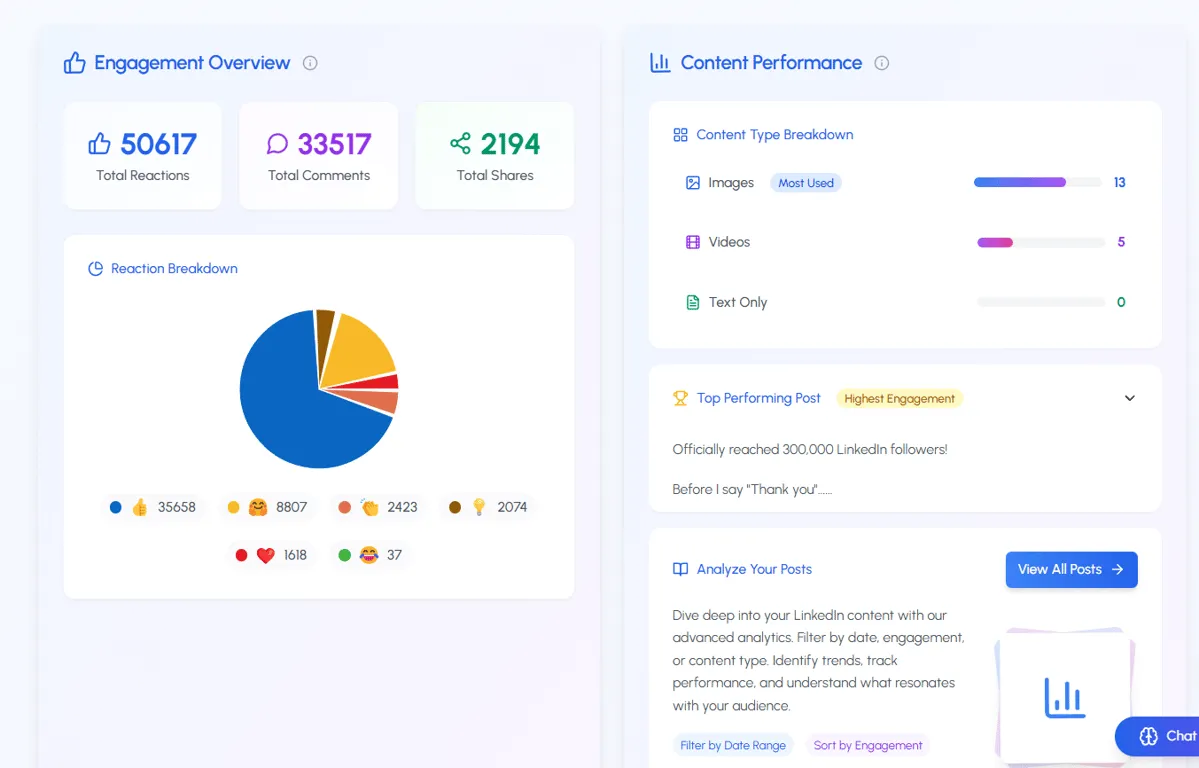
Conduct Quarterly Strategy Reviews
Personal branding is an iterative process that improves with systematic review and refinement. Every quarter, schedule a strategy review that examines:
Content performance patterns: Which topics, formats, and posting times generate the strongest engagement and conversion?
Audience growth and quality: Is your follower growth aligned with your ideal client profile? Are you attracting decision-makers in your target market?
Conversion effectiveness: How efficiently are you moving connections from engagement to meaningful business conversations?
Competitive positioning: How does your personal brand positioning compare to others in your space? Are there emerging opportunities for differentiation?
Based on these insights, make strategic adjustments to your content themes, engagement approach, and conversion tactics. This continuous improvement process ensures your personal brand remains relevant and effective.
Our guide on using analytics to improve your LinkedIn content strategy provides a detailed framework for these quarterly reviews.
Overcoming Common Personal Branding Challenges
Building a personal brand involves overcoming several common challenges that derail many professionals.
Finding Your Authentic Voice
Many struggle with sounding authentic while remaining professional. This challenge stems from overthinking content rather than speaking from genuine expertise.
The solution is developing a consistent writing voice that reflects your natural communication style. Record yourself explaining concepts to clients, then transcribe and refine this language to capture your authentic expertise. Over time, this becomes more natural and requires less editing.
As LinkedIn expert Mark Williams explains in his LinkedIn Masterclass: "Your authentic voice isn't unprofessional-it's your professional expertise expressed in your natural language."
LiGo helps solve this challenge by analyzing your writing style and generating content that matches your authentic voice while maintaining professionalism.
Maintaining Consistency During Busy Periods
Agency owners often struggle with consistent posting during client work surges. This inconsistency undermines brand building and algorithm visibility.
The most effective solution is implementing a content creation system that separates ideation, creation, and publishing. Set aside dedicated time blocks (2-3 hours monthly) for batch creating content during lighter periods. Then use scheduling tools to maintain consistent visibility even during hectic periods.
Using LiGo's scheduling features, you can maintain consistency even during your busiest periods by planning content weeks in advance.
Balancing Personal and Professional Content
Finding the right mix of personal and professional content challenges many professionals building LinkedIn brands. Too personal, and you risk appearing unprofessional; too corporate, and you become forgettable.
The solution is using personal stories strategically to illustrate professional points rather than sharing personal content without business context. This "personal with purpose" approach humanizes your expertise without crossing professional boundaries.
A general guideline is the 80/20 rule-80% professional insights with 20% personal context that reinforces your professional narrative. This balance maintains professionalism while creating memorable differentiation.
Conclusion: The Compounding Effect of Personal Branding
Building a personal brand on LinkedIn is not an overnight process-it's a long-term investment that compounds over time. The most successful LinkedIn personal brands are built through consistent value delivery, authentic engagement, and strategic positioning.
What makes this approach so powerful is the compound effect-each piece of content, each meaningful engagement, and each new connection builds upon previous efforts. While progress might seem slow initially, the momentum becomes increasingly powerful as your network, content library, and reputation grow.
By following this step-by-step approach, agency owners and founders can develop LinkedIn personal brands that not only increase visibility but generate tangible business opportunities. Remember that the most effective personal brands are built on genuine expertise and a sincere desire to help your audience solve their challenges.
For busy agency owners and founders, tools like LiGo can significantly streamline this process by generating content ideas aligned with your brand pillars, suggesting optimal posting times, and providing analytics to refine your strategy over time.




